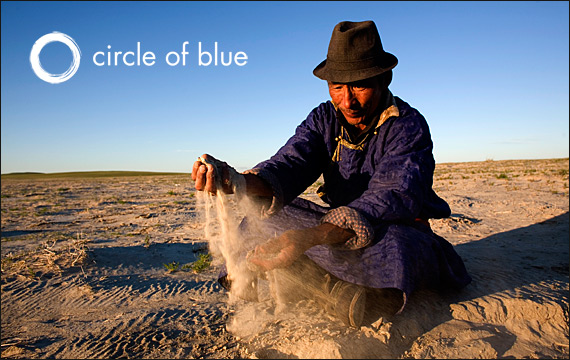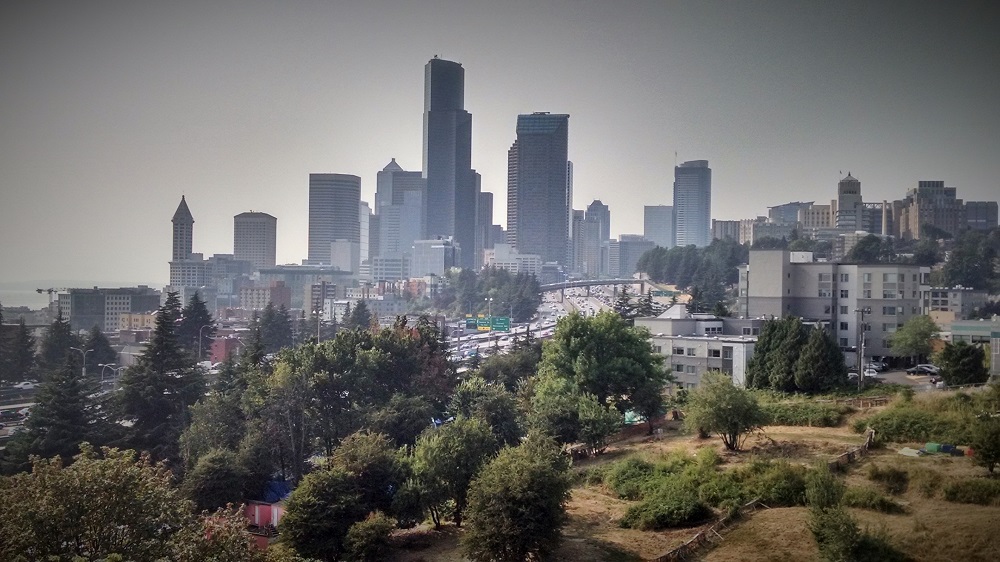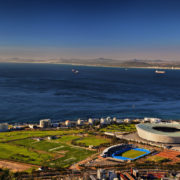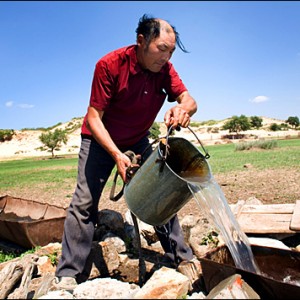China Faces Reign of Sand

INNER MONGOLIA, CHINA (January 21, 2008) – Furious dust and sandstorms from Inner Mongolia cripple airports, darken skies, and choke millions of people across East Asia every spring. According to “Reign of Sand,” the new multimedia report from Circle of Blue, the storms are growing in intensity and frequency, and the primary causes are deepening drought in northern China and the mismanagement of the largest grasslands on earth.
“It’s much more than a landscape surrendering to the sand,” said J. Carl Ganter, director of Circle of Blue, the journalism-based news, science and collaborative project covering water issues worldwide. “We’re looking at a crucial international economic and environmental story that has implications for us all.”
As China prepares for the Summer Olympic Games in August, international focus on its air pollution is increasing. The main target is to reduce urban smog from car and coal emissions, but China’s sand storms are an equal threat to air quality and human health. They are often driven by 80 mile-per-hour winds that last for days. These storms, along with the water shortages and the land degradation causing them, underscore the extreme stress that China’s economic development is putting on its environment and its 1.3 billion people.
“Reign of Sand” comes as China’s spring dust storms approach. Scientists say the severity and frequency of the dust storms reflect worsening conditions: Dryer climate, stronger winds, water shortages, over-grazing, population growth, and a clash between nomadic herders and the government over range and farmland management.
Part of a global water crisis
Globally, the UN estimates that two-thirds of the world’s population will live in areas of water stress within the next 20 years. The consequences are ominous. One of every three people on the planet lives without adequate clean water or sanitation. Some 6,000 people, mostly children, die each day from preventable, water-related diseases. And water has become an axis issue, intersecting civilization’s greatest challenges – poverty, health, economic development, climate, immigration, and financial and environmental security, to name a few.
In the first decade of the 21st century, more than 20 storms a year were able to bring life to a near standstill in Beijing and other regions of China, North Korea and South Korea—five times as many storms as occurred in the 1950s.
Typical is what happened early last April when the people of Liaoning and Shandong provinces in northeastern China—an area roughly the size of New Mexico and home to 130 million—awoke to the sound of grating winds and scratchy veils of dust that hung in their homes. Outside, yellow clouds of sand darkened the streets, and dust was so thick that residents were forced to stay indoors.
Circle of Blue reports that the steady desertification of Inner Mongolia is an important factor in steadily pushing an Asian Sahara of sand closer to Beijing, blackening the sky, and producing environmental refugees and social unrest in Inner Mongolia and throughout China.
While many finance theorists predict that China may become the preeminent industrialized nation this century, environmental economists say China is outrunning the capacity of its natural resources to sustain such rapid development, and could instead experience a frightening ecological collapse.
As recently as the 1960s, according to estimates by the Chinese environmental agency, almost three-quarters of Inner Mongolia was grass. The province’s thin soil, 15 inches of annual rainfall, and nomadic herders supported one of the planet’s most robust wild ranges, a grass ecosystem that stretched 1,500 miles east to west and more than 600 miles north to south in some places, nearly twice as large as France.
No longer. According to estimates by the United Nations, since 1980 desert has claimed 2 million acres of cropland, nearly 6 million acres of rangeland, and 16 million acres of forests in northern China, an area equivalent in size to Kentucky.
“These challenges are formidable, but we’re at a rare point in history when we can meld the expertise and enthusiasm of the world’s finest creative and scientific talents to inform and design solutions,” Ganter said. “This report underscores the power of exceptional storytelling to engage the public and policy makers in the critical decisions of our time. Where there is the will, there is a way.”
At a Glance
Desertification in Inner Mongolia
• The province’s thin soil, 15 inches of rainfall annually, and nomadic herders once supported one of the planet’s most robust wild ranges, a grass ecosystem nearly twice as large as France.
• Since 1980 desert has claimed 2 million acres of cropland, nearly 6 million acres of rangeland, and 16 million acres of forests in northern China.
• The steady desertification of northern China has put the world’s fastest growing economy, and 500 million people at risk of sand storms, health effects caused by blowing sand, and food shortages prompted by severe drought and water mismanagement.
• China planted a 74 million-acre “Great Green Wall” of trees, 2,800 miles long stretching from the northeast, through Inner Mongolia to Xinjiang in the far west. The desert is killing the trees.
Contact
Circle of Blue
Keith Schneider, senior editor
+1.844.324-7253 ext. 703
Wilson Center – China Environment Forum
Jennifer Turner
+1.202-691-4233
http://www.wilsoncenter.org/cef
Pacific Institute
press@pacinst.org
+1.510-251-1600
(statistics, water issues, policy)
Available media
high-resolution photographs, audio and video interviews
https://www.circleofblue.org/media_center
Eric Daigh
+1.844.324-7253
About
Circle of BlueFounded by leading journalists and scientists and based on the shores of the Great Lakes, Circle of Blue pioneers communications and information technology, informing decision making with original front-line reporting, dynamic data spaces and engaging social media. Circle of Blue is a nonprofit independent journalism project of the Pacific Institute. It was featured recently at the Aspen Ideas Festival and the Clinton Global Initiative.
Pacific InstituteThe Pacific Institute is dedicated to protecting our natural world, encouraging sustainable development, and improving global security. Based in Oakland, California, the Institute uses interdisciplinary analysis in order to develop real-world solutions to problems like water shortages, habitat destruction, global warming, and environmental injustice. Founded in 1982, the Institute celebrated its 20th Anniversary in 2007.PartnersCircle of Blue partners announced at the Clinton Global Initiative include the international photojournalism agency Contact Press Images; the Environmental Change and Security Program and China Environment Forum at the Woodrow Wilson International Center for Scholars; exhibit firm Evergreen Exhibitions; acclaimed artist Greg Mort; SustainAbility, the global independent consultancy for corporate responsibility and sustainability; and Sea Studios Foundation, producer of the PBS series, “Strange Days on Planet Earth.” Also included are Getty Images and Magnum Photos Foundation, and Globescan, the international public opinion and research firm.Circle of Blue is only possible through the generous financial support of individuals, foundations and companies. Please join us.
Comments
(high-resolution video available via ftp)
“I think that water pollution could very well be the catalyst that will enable people to push for greater change in the political system, for getting a cleaner environment…. When the water’s gone, life’s gone.”
Dr. Jennifer Turner
Director, China Environment Forum
Woodrow Wilson International Center for Scholars
“Ultimately, numbers don’t tell the story as well as pictures do, as well as stories do. And I think one of the challenges for water experts, or for policy makers, is in fact not to tell the story in numbers but to convert the numbers into things people really care about. to figure out a way to make 1.1 billion people without safe water something that means something more clearly to people, that people really care about, that in fact is not a number like 1.1 billion, but is a family that has a sick child. Or a girl who can’t go to school because she has to spend three or four hours a day walking miles to collect water that may not even be safe enough to drink. So ultimately it’s not about the numbers, it’s about the human aspects of water that are going to really convince people to take action, that are going top really convince policy makers to move forward.”
Peter Gleick
President
Pacific Institute
Learn more – Aspen Environment Forum
Learn more about these and other crucial environment issues – and hear more from Circle of Blue’s team – at the first ever Aspen Institute Aspen Environment Forum – a powerful, three-day exchange examining the future of our shared environment, March 26-29, 2008.
Links and Resources
Woodrow Wilson International Center for Scholars China Environment Forum
http://www.wilsoncenter.org/cef
Pacific Institute – The World’s Water
Pacific Institute – At the Crest of a Wave: A Proactive Approach to Corporate Water Strategy
Pacific Institute: A Proactive Approache to Corporate Water Strategy
World Economic Forum – Water Initiative
http://www.weforum.org/en/initiatives/water/index.htm
Clinton Global Initiative
http://www.clintonglobalinitiative.org
National Assessment of the Impacts of Climate Variability and Changehttp://www.pacinst.org/reports/national_assessment
Woodrow Wilson International Center for Scholars
Environmental Change and Security Program, “Navigating Peace”
http://www.wilsoncenter.org/water
Navigating Peace multimedia “Water Stories”
http://www.wilsoncenter.org/waterstories
China Environment Forum – Circle of Blue
Developing water stories in China: “Driving into the Ocean of Sand”
Great Lakes at risk
Great Lakes shrinking?
New York Times Sunday Magazine
The Perfect Drought
For Journalists covering water
The Poynter Institute – News University, “Covering Water Quality”
Covering Water Quality
Society of Environmental Journalists – Resources
SEJ Resources
Michigan State University Knight Center for Environmental Journalism
http://ej.msu.edu/resources.php
U.S. Drought Monitor
U.S. Drought Monitor
A news correspondent for Circle of Blue based out of Hawaii. She writes The Stream, Circle of Blue’s daily digest of international water news trends. Her interests include food security, ecology and the Great Lakes.
Contact Codi Kozacek









Leave a Reply
Want to join the discussion?Feel free to contribute!